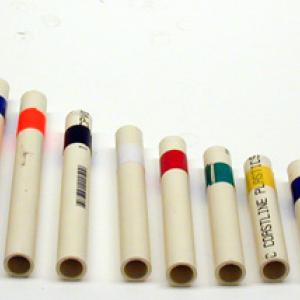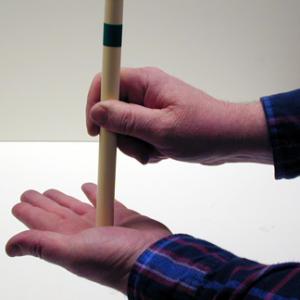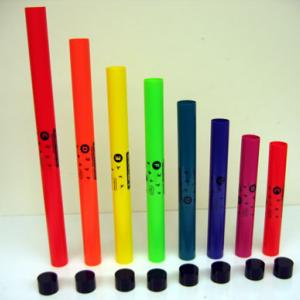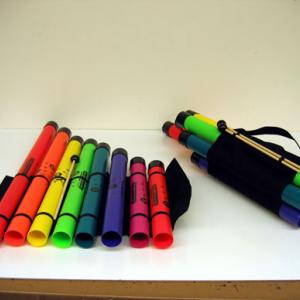College of Liberal Arts & Sciences
3D32.45 - PVC Instruments - Palm Pipes and Boomwhackers
While you can play the palm pipes by blowing across the end, some of the notes are very hard to play. The usual way to play these is to strike the end across the palm of your hand. Each length will have a different pitch. Since they are color coded you can place a transparency with different colored bars on the overhead projector. As you point to each different color the person that holds that colored palm pipe strikes his palm. Music can be written and played with this method.
Another variation is to close off one end of the tube and blow across the other end. The frequency heard when striking the pipe against your hand should also be the same frequency heard when blowing across the pipe.
The Boomwhackers are just a larger version of the palm pipes. These are meant to be struck on the side with the mallet or the edge of a table. These also come with a set of caps so that you can show that the fundamental changes by one octave depending on whether the pipe is open or closed.
The 3-D printed mouth pieces and horn are designed to fit onto 1/2 inch, schedule 40, PVC water pipe. A variety of pipe lengths, elbows, T's, and couplers are available so you can make the instrument shape or design of your choice.
- Muge Aygun, Hasan Sahin Kizicik, "Open or One-End-Closed Tubes for Beethoven's Ninth Symphony: Boomwhackers", TPT, Vol. 61, #9, Dec. 2023, p. 777.
- Thomas Allen, Alex Chally, Bradley Moser, and Ralf Widenhorn, "Sound Propagation, Reflection, and Its Relevance to Ultrasound Imaging", TPT, Vol. 57, #3, Mar. 2019, p. 134.
- Michael J. Ruiz, "Boomwhackers and End-Pipe Corrections", TPT, Vol. 52, #2, Feb. 2014, p. 73.
- Bob Brazzle, "Inexpensive Instruments for a Sound Unit", TPT, Vol. 49, #4, Apr. 2011, p. 228.
- M. Bacon and Steven Torok, "An Experimental Investigation of the End Effects for Blue Man Group Pipes", TPT, Vol. 49, #3, Mar. 2011, p. 152.
- Meredith B. McCambridge, "A Straw Quartet", TPT, Vol. 29, #9, Dec. 1991, p. 571.
- Stephen Luzader, "PC and PVC Acoustics Demonstrations", TPT, Vol. 28, #7, Oct. 1990, p. 459.
- James E. Szeszol and James Luzader, "Doing Physics: Pipe Music", TPT, Vol. 25, #3, Mar. 1987, p. 172.
- Joe Pizzo, "Echo Tube", TPT, Vol. 24, #7, Oct. 1986, p. 428.
- "Vibration in Pipes", TPT, Vol. 18, #5, May 1980, p. 383, also A Potpourri of Physics Teaching Ideas - Sounds, p. 253.
- W-415: "Monochord - Pan Pipes", DICK and RAE Physics Demo Notebook.
- W-190: "Pat the Pipe", DICK and RAE Physics Demo Notebook.
- George M. Hopkins, "Sound", Experimental Science, p. 122.
- Don Rathjen, Paul Doherty, "Palm Pipes", Square Wheels, 2002, p. 59.
- Jodi and Roy McCullough, "Sound with a Toy Flute", The Role of Toys in Teaching Physics, p. 4.39.
- Pat Murphy, Ellen Macaulay, and the staff of the Exploratorium, "Palm Pipes", Exploratopia, p. 220.
- Gregory Mone, "Digital Aboriginal", Popular Science, April 2010, p. 72.
- Jearl Walker, "3.37, Didgeridoo", The Flying Circus of Physics Ed. 2, p. 162.
- 7.03: R.D. Edge, "Waves in a Pipe", String & Sticky Tape Experiments.
- Gene Easter, Bill Reitz, and Walter Smith, "Palm Pipes - 'Handy' Musical Instruments".
- Tom Senior, "Musical (?) Straws".
Disclaimer: These demonstrations are provided only for illustrative use by persons affiliated with The University of Iowa and only under the direction of a trained instructor or physicist. The University of Iowa is not responsible for demonstrations performed by those using their own equipment or who choose to use this reference material for their own purpose. The demonstrations included here are within the public domain and can be found in materials contained in libraries, bookstores, and through electronic sources. Performing all or any portion of any of these demonstrations, with or without revisions not depicted here entails inherent risks. These risks include, without limitation, bodily injury (and possibly death), including risks to health that may be temporary or permanent and that may exacerbate a pre-existing medical condition; and property loss or damage. Anyone performing any part of these demonstrations, even with revisions, knowingly and voluntarily assumes all risks associated with them.



